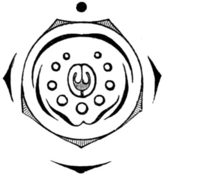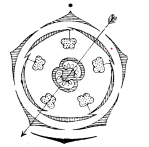
Take one flower each of the families Fabaceae and Solanaceae and write its semi-technical description. Also draw their floral diagram after studying them.
Answer
441k+ views
Hint: The floral formula is a means by which numbers, letters and various symbols represent the configuration of a flower, providing substantial details in a compact form about the flower. In order to classify higher taxa, it may describe individual organisms or can be generalized, typically giving ranges of organ numbers.
Complete answer:
1)Fabaceae/Papilionaceae- Pisum sativum
A subdivision of the Leguminoseae family is the Fabaceae/Papilionaceae.
Vegetative Characteristics:
Habit: Pinnate complex, alternately arranged along folate stipules with leaf tendrils with the pulvinus present at the leaf root.
Root: With root nodules, tap root system.
Floral Characteristics:
Inflorescence: Racemose, axial in general rather than terminal
Flower: There are zygomorphic and bisexual flowers.
Calyx: It comprises five gamosepalous sepals when imbricated by aestivation.
Corolla: Comprises five (polypetalae) petals with vexillary estivation.
Androecium: It consists of ten diadelphous anthers with diadelphous anthers.
Gynoecium: Monocarpellary superior ovary with median placentation, unilocular.
Fruit: Legume pod with seeds that are non-endospermic.
Economic importance: For producing different cooking recipes, peas are used as vegetables.
2)Solanaceae - Solanum nigrum
Vegetative Characteristics:
Habit: Herbaceous, upright vine
Leaves: Simple, with reticulate venation, exstipulate leaves
Stem: Various branches of an upright stem.
Floral Characteristics:
Inflorescence: Axillary and solitary
Flowers: Actinomorphous flowers, bisexual flowers
Calyx: Calyx is made up of five united and persistent sepals. Valvate is Aestivation.
Corolla: Corolla consists of five valvate aestivation united petals.
Androecium: Five epipetalous stamens are composed of it.
Gynoecium: It consists of an axile placentation of the bicarpellary syncarpous superior ovary.
Fruits: Berry Seeds: Endospermous, various
Economic significance: Used for medical use.


Floral diagram - Papilionaceae Floral diagram - Solanaceae
Note: Floral formulae, however, lack knowledge on the details of the location of the organ. In the way floral formulas are projected, American and European traditions vary, while also providing the same material. For an entire family or for a particular plant, floral formulations may be given.
Complete answer:
1)Fabaceae/Papilionaceae- Pisum sativum
A subdivision of the Leguminoseae family is the Fabaceae/Papilionaceae.
Vegetative Characteristics:
Habit: Pinnate complex, alternately arranged along folate stipules with leaf tendrils with the pulvinus present at the leaf root.
Root: With root nodules, tap root system.
Floral Characteristics:
Inflorescence: Racemose, axial in general rather than terminal
Flower: There are zygomorphic and bisexual flowers.
Calyx: It comprises five gamosepalous sepals when imbricated by aestivation.
Corolla: Comprises five (polypetalae) petals with vexillary estivation.
Androecium: It consists of ten diadelphous anthers with diadelphous anthers.
Gynoecium: Monocarpellary superior ovary with median placentation, unilocular.
Fruit: Legume pod with seeds that are non-endospermic.
Economic importance: For producing different cooking recipes, peas are used as vegetables.
2)Solanaceae - Solanum nigrum
Vegetative Characteristics:
Habit: Herbaceous, upright vine
Leaves: Simple, with reticulate venation, exstipulate leaves
Stem: Various branches of an upright stem.
Floral Characteristics:
Inflorescence: Axillary and solitary
Flowers: Actinomorphous flowers, bisexual flowers
Calyx: Calyx is made up of five united and persistent sepals. Valvate is Aestivation.
Corolla: Corolla consists of five valvate aestivation united petals.
Androecium: Five epipetalous stamens are composed of it.
Gynoecium: It consists of an axile placentation of the bicarpellary syncarpous superior ovary.
Fruits: Berry Seeds: Endospermous, various
Economic significance: Used for medical use.


Floral diagram - Papilionaceae Floral diagram - Solanaceae
Note: Floral formulae, however, lack knowledge on the details of the location of the organ. In the way floral formulas are projected, American and European traditions vary, while also providing the same material. For an entire family or for a particular plant, floral formulations may be given.
Recently Updated Pages
What happen to the gravitational force between two class 11 physics CBSE

Compare the properties of protons electrons and ne class 11 chemistry CBSE

Find the ratio in which the yaxis divides the line class 11 maths CBSE

The perimeter of a triangle with vertices 0 4 0 0 and class 11 maths CBSE

Number of oneone functions from A to B where nA 4 and class 11 maths CBSE

Maximum number of Hatoms that can be exchanged with class 11 chemistry CBSE

Trending doubts
10 examples of friction in our daily life

The correct order of melting point of 14th group elements class 11 chemistry CBSE

Difference Between Prokaryotic Cells and Eukaryotic Cells

One Metric ton is equal to kg A 10000 B 1000 C 100 class 11 physics CBSE

What is the specific heat capacity of ice water and class 11 physics CBSE

State and prove Bernoullis theorem class 11 physics CBSE




